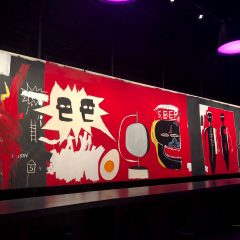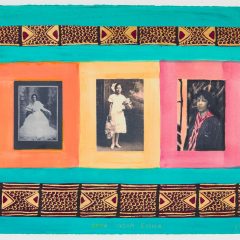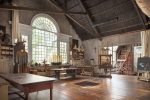The Dia: Beacon, 80 miles north of New York City, houses an impressive collection of pared down, phenomenological works from the past fifty years by Dan Flavin, Andy Warhol, Sol Lewitt, Imi Knoebel, Walter De Maria, Donald Judd, Gerhard Richter, Robert Smithson, Fred Sanbeck, Joseph Beuys, Bernd and Hilla Becker, William Heizer, Lawrence Weiner, Richard Serra, John Chamberlain, Robert Ryman, Agnes Martin, Franz Erhard Walther, Louise Bourgeois, Robert Irwin, On Kawara, Bruce Nauman, and (not on view currently) Blinky Palermo and George Trakas.
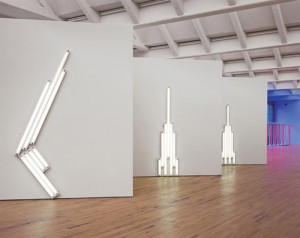
The museum is a squat brick building—a former Nabsico box printing factory—lit almost exclusively by natural light that pours through skylights perforating the ceiling. The Foundation was founded in 1974 with the aim of supporting site-specific artwork, and continues to manage outdoor works such as Smithson’s Spiral Jetty in Utah and De Maria’s Lightning Field in New Mexico. Dia has a strict no photography policy, but the gift shop can supply you with keepsakes.
The first project a viewer encounters in the museum is Dan Flavin’s “monuments” for V. Tatlin, the Russian Constructivist best known for his proposal to build a colossal spiral tower of glass and steel. While pieces from this series exist in the multi-colored fluorescent tubes that Flavin is most known for, the light sculptures installed at Dia: Beacon shine pure, angelic white. Each “monument” is its own entity, glowing quietly on an individual wall situated diagonal to the viewer. What is stunning about these pieces is not the mysterious combinations of colors from competing light sources, but the two-dimensional forms Flavin organized with the fixtures. They offer a rigid poeticism—the result of arranging pre-fabricated materials dispensed in standard dimensions.
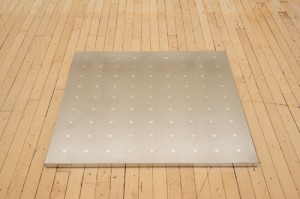
Walter De Maria’s Silver Meters and Gold Meters earn a type of beauty through similar means. The two series are installed in one line on the floor of their own gallery. Each is comprised of eight square stainless-steel plates, three feet wide. Each plate has inserted into it a troy ounce of silver or gold, which is installed as a plug flush with the surface. Within each series, silver or gold, the number of plugs in each panel jumps by square numbers: the first plate having one plug, the second having four, etc., so that the plugs get indiscernibly shallower with each increasing plate. The installation—all 16 plates laid out flat in ascending then descending order—barely murmurs, spanning the entire length of a gallery in one dimension and just one inch in another. Its limitations, however, bestow upon it an expressiveness that is unique to Minimalism.
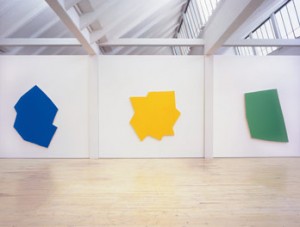
The first instance of blatant color found in the museum is Imi Knoebel’s 24 Farben-Für Blinky (24 Colors-For Blinky, a series of large panels cut into abstract shapes like excited quotation blobs. Knoebel completed the project shortly after the death of color formalist and close friend, Blinky Palermo. It was his initial exploration with hue. The panels are sculptures wearing the cloak of painting. They are visually expressive—anti-conformist shapes dressed in flamboyant color–and they contribute an exciting eruption to the museum’s collection. They do not, however, share the particular reserved expressiveness key to Flavin and De Maria. Dia’s personality hinges on constraint and these lose their cool a little.
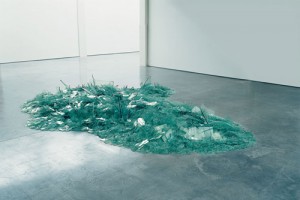
Robert Smithson’s materials set him apart from the other artists at Dia. His glass and earth particle sculptures are gatherings of splintered material—a language that differs greatly from the solid bodies and clean surfaces that fill most of the museum. The piles of gravel Smithson employs in Four-sided Vortex, a mound of dirt which encapsulates a mirrored box, and Leaning Mirror, allude to a material reality–nature–that Flavin and De Maria’s sculptures deny (while creating, instead, a religion of the industrial). Text printed on a glossy informational card in the gallery offers this idea: “Smithson’s work suggests that the concrete materiality of sculpture depends on the mind’s ability to see metaphorically in order to comprehend meanings…” Smithson’s sculpture relies on a parallel metaphor: the viewer sees one thing and understands that it stands for something else. His work relates back to the physical world; it exists to affirm nature in a hyper-industrialized society. Flavin, De Maria, and Judd’s work, on the other hand, does not necessitate that the viewer “sees metaphorically”. Instead, the metaphor proposed by their work is embedded in the work itself: the viewer literally sees the metaphor, because these artists’ work does not allude to our lived reality but to a new, unexperienced reality. The hyper-specific forms created from industrial materials propose an alternate set of laws. They are not, like Albers or Mondrian, form for the sake of form, but rather form as metaphor/meaning. They are like dancers in that their beings in space elicit significance.
Dia: Beacon is accessible by the Metro-North railroad from Grand Central, New York. Other notable installations include Andy Warhol’s Shadows, Michael Heizer’s North East South West, and Sol LeWitt’s Drawing Series. Winter hours are Friday through Monday, 11AM to 4PM. The train will take you past hills that fall into the Hudson River, with strange ice formations in the winter time. For lunch or coffee, Main St. is a ten minute walk from the train station the opposite direction from Dia.


